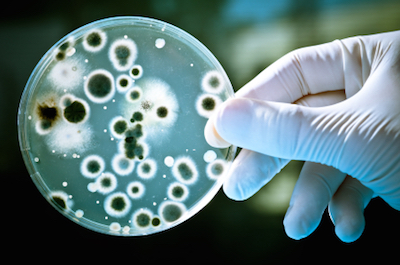By Greg Neimeyer
 The mid-century discovery of antibiotic medications represented an epic scientific advance against bacterial infections and death. But it didn’t take bacteria long to begin to fight back. The first counter-offensive was something of a surprise, with the bacterial armies wielding a potent secret weapon in the form of impenetrable new armor: resistance. Indeed, the bacterial propensity to produce resistance to anti-bacterial medications enjoined medical research in a century-long series of battles to out-flank the battle-hardened bacteria. Science was forced to develop increasingly savvy serums to counter the microbial resistances that held science fast in its tracts until, it seemed, that the tide began to turn in favor of the microbial mighty-mights.
The mid-century discovery of antibiotic medications represented an epic scientific advance against bacterial infections and death. But it didn’t take bacteria long to begin to fight back. The first counter-offensive was something of a surprise, with the bacterial armies wielding a potent secret weapon in the form of impenetrable new armor: resistance. Indeed, the bacterial propensity to produce resistance to anti-bacterial medications enjoined medical research in a century-long series of battles to out-flank the battle-hardened bacteria. Science was forced to develop increasingly savvy serums to counter the microbial resistances that held science fast in its tracts until, it seemed, that the tide began to turn in favor of the microbial mighty-mights.
The clearest signal of their success can gauged by the fact that nearly 25,000 people in the United States die each year from antibiotic resistant bacteria. Moreover, These bacterial advances have been met largely by scientific retreat. Pharmaceutical companies have tired of the costs associated with producing ever more costly weaponry in their fight against bacteria, only to find their adversaries once against deflecting these scientific assaults and staging further offensives in response. Pharmaceutical companies even began abandoning the battlefields in favor of richer spoils in greener pastures such as the fields of cancer
and hepatitis.
Enter now, however, a potential battalion of reinforcements the like of which have never been seen on the battlefield. Fueled by scientific advances in the field of “sociomicrobiology” medicine may now be poised to begin developing a range of secret weapons based on the surprising discovery that bacteria are, in fact, social creatures, and that interrupting their interaction and communication may be a key to vanquishing their virulence.
Like armies of ants or battalions of bees, bacteria coordinate their actions in support of their collective success. And medicine may now, for the first time, begin to target the supply lines that support them. Previous antibiotic ammunition has always been aimed at the level of the individual bacteria, as it turns out, weakening their cell walls for example so that they burst, or pumping them full of toxins to poison them. Bacteria have been surprisingly resilient in relation to these efforts however, quickly countering these moves by multiplying internal bilge pumps that disgorge the toxins and permit the ongoing bacterial advance. Sociomicrobiology, however, takes aim at the essential interaction among bacteria, interfering with the communication and interaction that is necessary, for exams, for them to gain and distribute nutrition. One brand of bacteria feeds on iron for example. In human blood Iron is locked up tight in hemoglobin so one inventive bacterial strand called Pseudomonas, dispatches special troops armed with iron-siphoning weaponry called siderophores to unlock the nutrient and release it to their iron-starved comrades-in-arms. The effort is deeply social and cooperative because the actions of one cell benefit the overall infection, often at the expense of the individual cell. By interfering with their microbial chain-of-command, modern science is developing mechanisms for interrupting bacterial communication and coordination, leaving them unable to unlock or unload the iron rich nutrients essential to their survival. In effect the sociobiological solution rallies to the call of “United they stand divided they fall.” So the next step in bacterial warfare may involve moving from antibacterial medications that target the bacteria themselves to antisocial medications that target the interaction and coordination that are essential to their success and to their survival.
The Secular Policy Institute supports continuing research to better understand and combat bacterial processes and to thwart the mechanisms of resistance that have made them such challenging obstacles to the advance of medical science.
